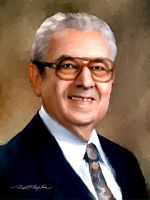
Herbert C Brown Ph.D.
The Nobel Prize in Chemistry 1979
The President's National Medel of Sciences - Physical Sciences, 1969
Nobel co-recipient Georg Wittig
Organic Chemist. Development of use of boron into important reagents in organic synthesis. School, advanced several times, graduating at 12; refused further advancement, avoiding being sister's classmate.
Graduating, Depression years, future wife Sarah gave him gift, Stock's 'Hydrides of Boron and Silicon' because cheapest chemistry book! Led to Nobel Prize!
Biography
By Dan Lednicer Ph.D. Organic/Medicinal Chemist
Nobel prizes in many of the sciences are awarded in recognition of some singular achievement. The Nobel Prize in Physics for example may be awarded to a relatively young scientist whose investigations provide a new insight to the nature of matter. The Nobel Prize for Chemistry covers the various specialized areas of this broad scientific discipline. Organic chemistry, that is, the chemistry of carbon compounds, comprises one of those disciplines. This field differs from many of the other sciences by the fact that it comprises of a large body of settled science. It is consequently unlikely that an organic chemist will come up with some singular achievement. The Nobel Prize in that discipline has not infrequently been awarded for work that has led to the development of new reagents which have made possible hitherto difficult transforms. Awards for new reagents are more often than not given years after the invention when the new method has come to be used routinely in the laboratory. In this case the 1979 Nobel Prize was awarded jointly to Herbert C. Brown and Georg Wittig "…for their development of the use of boron and phosphorus containing compounds into important reagents in organic synthesis".
Herbert Brown was born in London, England in 1912 to the Ukrainian immigrant couple named Brovanik. The family emigrated to the U.S. in 1914 to join the father's parents and other members of his family in Chicago. The family name was changed for the grandfather's name had been anglicized to Brown. The country was deeply enmeshed in the depression when Herbert graduated from high school. Finances thus dictated their son Herbert have a somewhat unusual higher education. He thus began by obtaining an Associate's degree from Wright Junior College in Chicago in 1935. His outstanding results on a competitive exam led to the award of a scholarship to the University of Chicago. He completed what was normally a two-year sequence in just one year graduating from the University in 1936 with a B.S. in chemistry. On graduating, Brown stayed on at the University to conduct graduate research under Herman I. Schlesinger. The latter was renowned for his research on metal hydrides that comprise a class of reactive molecules in which one or more hydrogen atoms are connected directly to a metallic element. In an autobiographical sketch Brown attributes his choice of a research topic, diborane, a hydride of boron to a graduation gift from his wife-to-be of a book on the hydrides of boron and silicon. He was awarded his Ph.D. in chemistry in 1938. With jobs for chemists still very scarce, he chose to stay on in Schlesinger's group as a research assistant with the title of Instructor. In 1943 Brown accepted a position of Assistant Professor at Wayne University, now Wayne State in Detroit. He was promoted to Associate Professor in 1946. He moved to Purdue University in West Lafayette, Indiana in 1947 now as full Professor. Since his research involved mainly metal hydrides he joined the Division of Inorganic Chemistry at Purdue in spite of the fact that the work benefited mainly organic chemistry. Brown was named Wetherill Distinguished Professor in 1959 and then Professor Emeritus in 1978. From that point on his research group comprised entirely of post-doctoral fellows. He died in 2004 at the age of 92. Purdue renamed the chemistry building Herbert C. Brown Laboratory of Chemistry in his honor. He received numerous other awards in his lifetime including the American Chemical Society's Priestley Medal (1981), the Society for Chemical Industry's Perkin Medal (1982) and the National Academy of Science Award in Chemical Sciences (1987). The American Chemical Society currently offers the "Herbert C. Brown Award for Creative Research in Synthetic Methods" supported.by the Purdue Borane Research Fund and Herbert C. Brown Award Endowment'
Diborane, B2H6, the hydride that Brown chose to study was to be the center of his research for the remainder of his career. When he began his research the molecule was considered an exotic species available in only minute quantities. His first task comprised developing a method for producing that molecule in practical quantity. That accomplished, Brown launched on a systematic study of the properties of diborane. He discovered that the molecule would add hydrogen to the double bond that connects oxygen to carbon bonds in aldehydes, ketones and esters; treating the addition product with water then afforded the corresponding alcohols. This provided a more convenient alternative to the very few methods that existed at that time for achieving this reaction, termed reduction. The then-available methods involved handling very reactive chemicals such as elemental sodium metal. The fact that diborane is an unstable gas at room temperature however means that it has to be used in solution in organic solvents. Further research led to the development of borohydride salts. Those solid derivatives are very stable and can be stored at room temperature in simple containers. The best known of these is sodium borohydride, NaBH4, a molecule used extensively by organic chemists for reducing aldehydes and ketones (but not esters). Investigators located principally in Browns laboratory but also elsewhere have produced a series of modified borohydrides that will selectively reduce specific organic functional groups. Sodium triacetoxyborohydride, NaBHAc3, a reagent in which all but one of the hydrogens in sodium borohydride has been replaced by an acetoxy group (CH3C=O) will, for example, reduce an aldehyde in preference to a ketone or ester even when both are present in the same molecule. The observation that diborane would also add to carbon-to-carbon double bonds opened an entirely new area of research. Reaction of the resulting product, called a borane, with an oxidizing agent such as hydrogen peroxide replaces boron by a hydroxyl group. This then affords a novel technique for introducing alcohol group in molecules whose structure contains carbon to carbon double bonds. Boron will add to the less substituted carbon in the case of unsymmetrical double bonds. This is the opposite orientation of that which other reagents add to such double bonds. Brown's laboratory then went on to develop a series of derivatives of diborane in which all but one of the hydrogen atoms are replaced by carbon or some other atom. The resulting organoboranes among other properties add more selectively to double bonds. They then went on to develop technology for replacing the organoborane that had been newly introduced by a series of other substituents such as for example bromine or sulfur. Replacing boron by ammonia afforded a means for creating amines.
Though his name is associated with organoboranes Brown's research programs covered a range of topics beyond those molecules. His interests included the influence of steric effects on chemical reactions. Organic molecules actually comprise three dimensional entities endowed with bulk. Steric effects involve the circumstance that parts of some mole may obstruct the regions where a reaction is to take place. The observable effect is a decrease of the rate of reaction or even preventing it in extreme cases.
Herbert Charles Brown, A Biographical Memoir by Ei - Ichi Negishi, National Academy of Sciences, 15 pages. Ei - Ichi Negishi is Chemistry Nobelist, 2010
Herbert Charles Brown Interviewed by R. B. Eckles. Transcript of oral history interview recorded on Sep 22, 1970 for the Archives of Purdue University. 34 pages.

Herbert Charles Brown
Find in a library near you. In Worldcat page, click book of interest to you. Scroll down to libraries which possess book. Possibly more than one person with the same name.
Discover Your Abilities and Aspirations!
 $10 $25 $50 $100 Other
$10 $25 $50 $100 Other
Tax Exempt 501(c)3 Non-Profit Organization
Any Currency
“…the peace that is found in libraries and laboratories…” - Louis Pasteur
Copyright © 2023 Ganga Library Inc. All Rights reserved.;

Photo Purdue University. Painting Tim Tompkins PaintHistory.com
Name: Herbert Charles Brown
Birth: 22 May 1912, London, United Kingdom
Death: 19 December 2004, Lafayette, IN, USA
Institution: Purdue University, West Lafayette, IN, USA
Award: "for their development of the use of boron- and phosphorus-containing compounds, respectively, into important reagents in organic synthesis"
Subject: Organic chemistry
Portion of cash: 1/2
Biography
Inventory of H.C. Brown papers
Books
Patents
Videos
Death
Family
Honoring H.C. Brown
Health
Livelihood
Prediction
Defining Moment
Humor/Quotations
Youth













